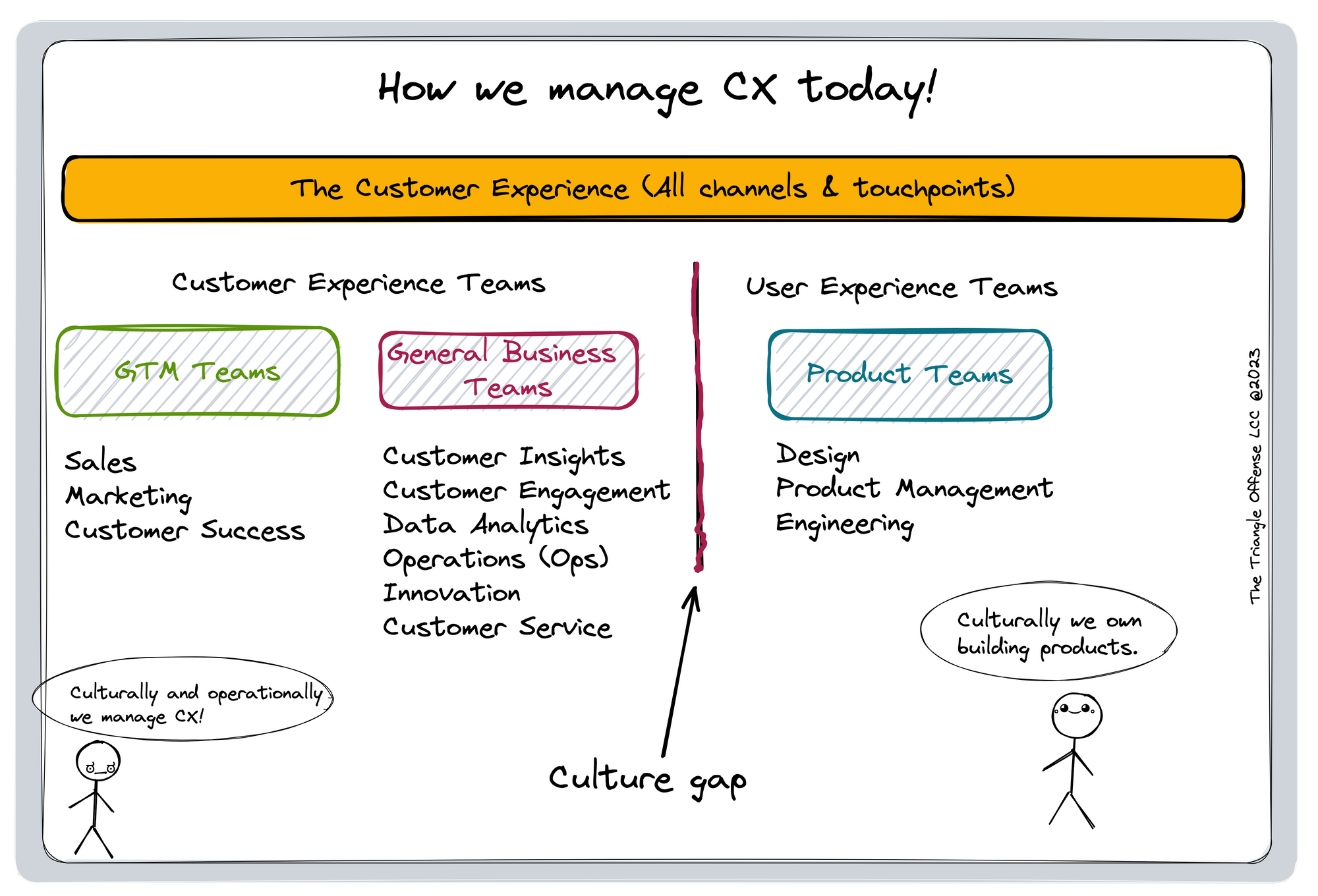CX vs UX
Explore the crucial differences between Customer Experience (CX) and User Experience (UX) as they play unique roles in business organizations.

Customer experience (CX) and user experience (UX) are common business topics. However, sometimes people get the two terms confused. Understanding the difference between CX and UX is essential.
For starters, the acronym CX describes the entire customer experience, including their experience with the website, app, phone service, marketing, and the products and services themselves. CX activities like customer support/success, customer research, operations, marketing, and sales are spread across the go-to-market (GTM) and general business teams.
On the other hand, UX is focused on a digital product or service experience as well as on that digital product or service’s user. UX activities, including design, are typically the responsibility of product teams comprising product managers, product designers, and software engineers.
CX and UX activities are meant to help create, maintain, and innovate a business’s entire customer experience. Where things can get confusing for people working in or operating a business is figuring out who is responsible for what and why.
The Customer Experience and the Role of UX

Take a look at the image above. All three teams are co-responsible for creating a great customer experience, but each team has its own fundamental culture. What do I mean by culture? Well, in a culture, people use specific acronyms and words—they create a specialized language to speak. Rituals, like specific types of meetings, are also part of the culture, as is the team’s documentation.
Now, imagine three different cultures operating within one business organization, all trying to improve the customer experience from their perspective. They’re all tasked with CX and UX responsibilities and will execute them to improve their area of the customer experience.
User experience (UX) falls under the umbrella of CX. For example:
Scenario: Retrieve cash from an ATM.
Tasks: Let's say you are going to your bank’s ATM to pull some cash out. You drive to the bank, use the drive-through, and put your bank card into the machine. You then enter the desired amount of money you want to withdraw. The machine whirrs for a moment, and then spits out the cash you want. You indicate that your transaction is complete and pull your bank card out of the machine. You peel out of the drive-through and continue the rest of your day.
Only when you touched the digital interface of the bank machine did you interact with that product’s UX, and while directly interacting with it, you become the product user. Everything else you experienced was part of the broader customer experience.
The UX activities within the customer experience are critical, but UX ladders into the customer experience and surfaces when the customer utilizes a digital product or service. In that moment, the customer becomes the digital product user before seamlessly switching back to the more extensive customer experience.
It's easy to get into the weeds, but I wanted to simplify this topic, so I’ve created a comparison table for you to view. The table highlights the biggest differences between CX and UX. I suggest understanding each discipline’s broad strokes and then looking at the details.
Comparison Table: Highlighting the Differences Between CX and UX
| Customer Experience (CX) | User Experience (UX) | |
|---|---|---|
| Focuses on overall interaction with a brand or company | Focuses on interaction with a specific product or service | |
| It encompasses every touchpoint, including sales, support, etc. | Limited to the design and usability of a product or service | |
| It aims to create positive emotions throughout the customer journey | It aims to create a seamless and efficient experience | |
| Covers both online and offline channels | Primarily addresses digital products or platforms | |
| An ongoing, long-term process | Focused on the immediate experience during product use | |
| Measures customer satisfaction, loyalty, and advocacy | Measures usability, efficiency, and user satisfaction | |
| Aligns business goals with customer needs and expectations | Improves product design and functionality for user satisfaction | |
| Managed by cross-functional teams | Primarily the responsibility of designers, developers, etc. | |
| Uses feedback from various sources to improve the customer journey | Uses user testing, analytics, and direct feedback to optimize the design | |
| The goal is to create loyal customers and brand advocates | The goal is to create a satisfying and easy-to-use product |
I haven’t included research methods in this table. For those methods, see this Triangle Offense post on the most common CX research methods. Also, here is an overview of standard UX research methods.
Summary
You must be mindful of the different cultures operating in your business organization, including the CX and UX sub-cultures. I would encourage you to think about an encounter in a meeting or conversation that highlighted a gap in your cultural understanding and remember Michael Jordan’s words:
Talent wins games, but teamwork and intelligence win championships.
Ultimately, all three teams serve the customer, but understanding where the different CX and UX activities cross over and how you engage the different cultures across an organization should, in the end, benefit the customer most. Regardless of culture, that kind of cooperation should be top of mind for everyone.
Written by Leo Vroegindewey, B2B CX Consultant
Get in touch to improve your customer experience and increase sales. Let's talk about how I can help your business grow. Email me.
You can find me on X or LinkedIn.